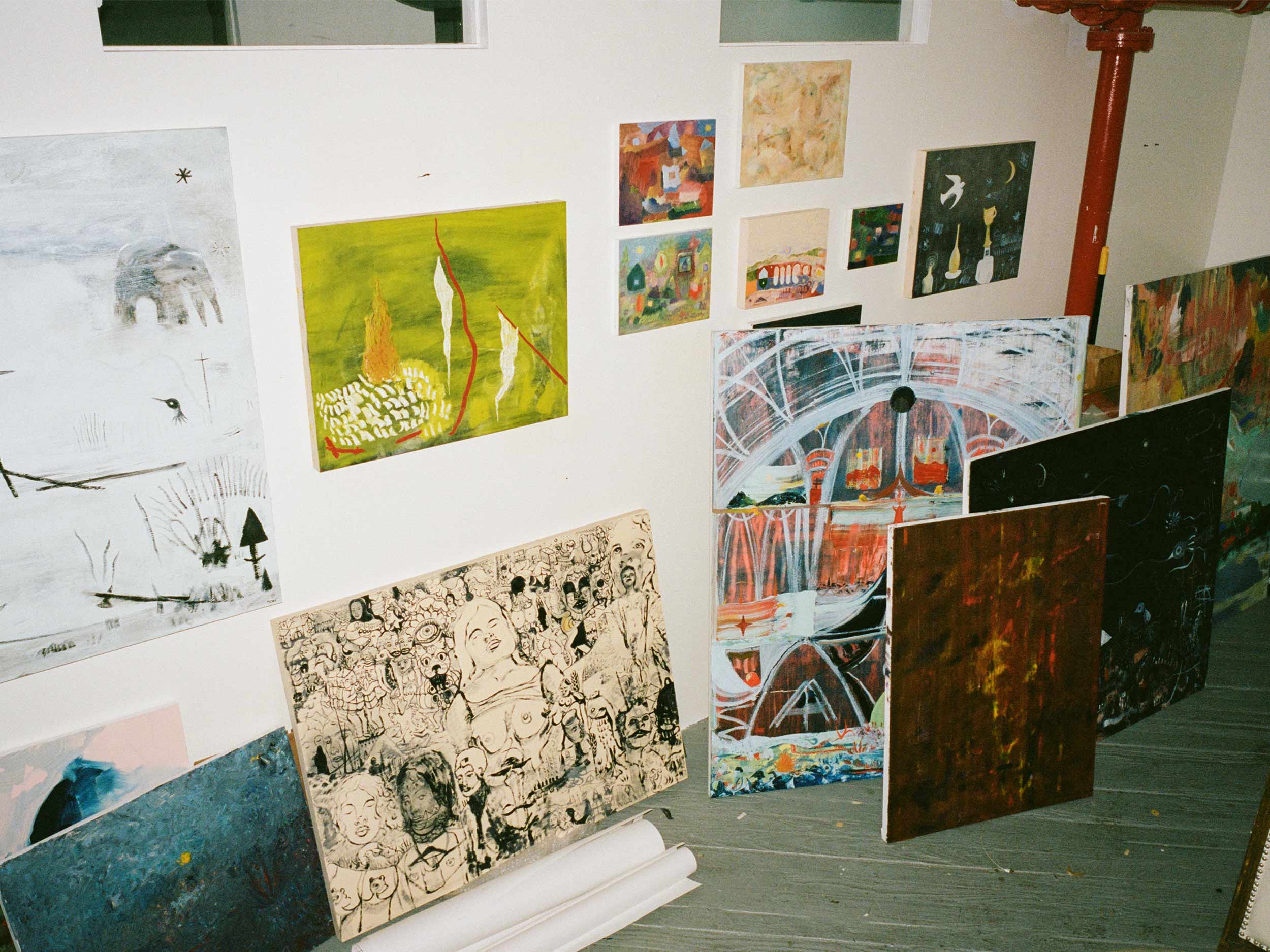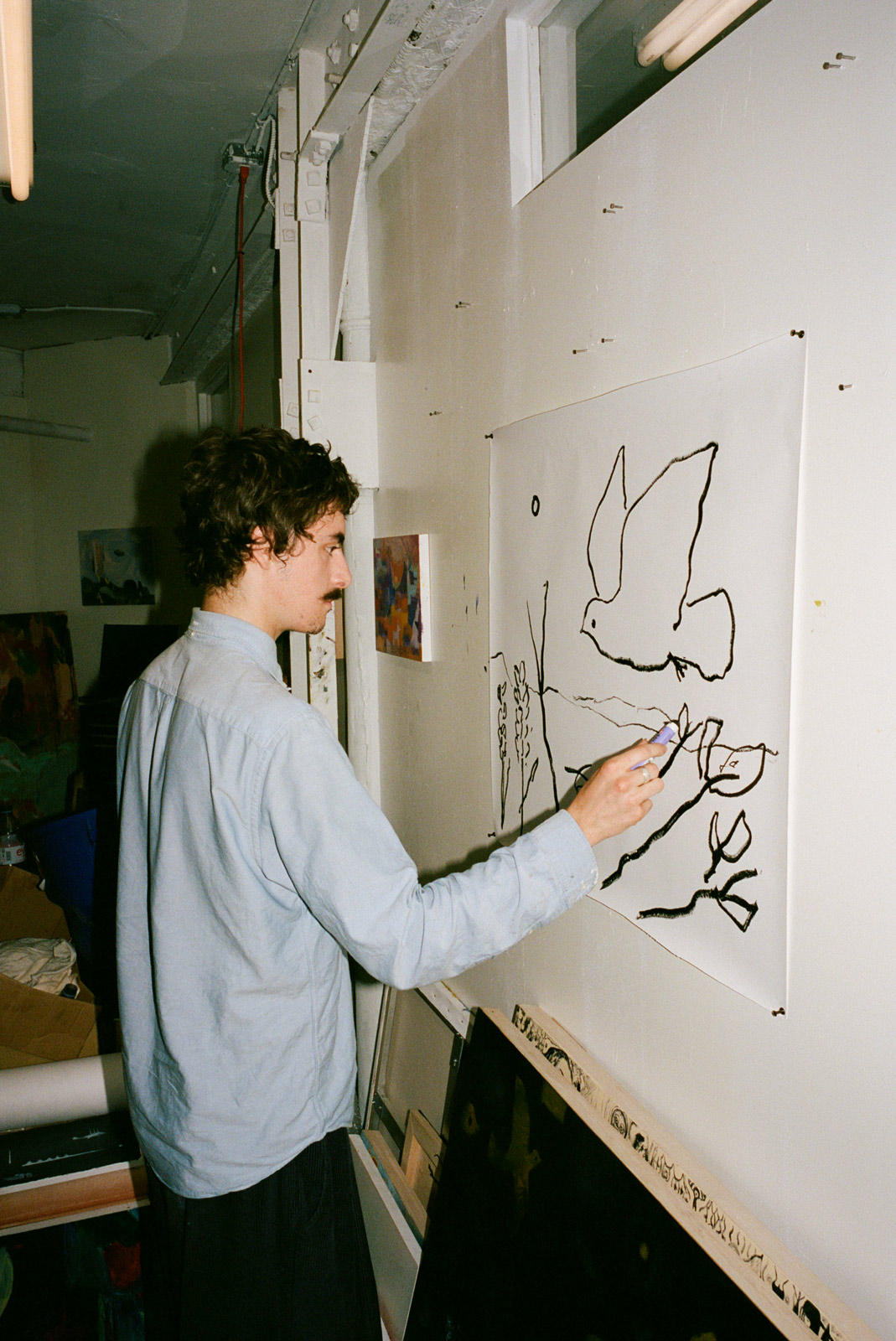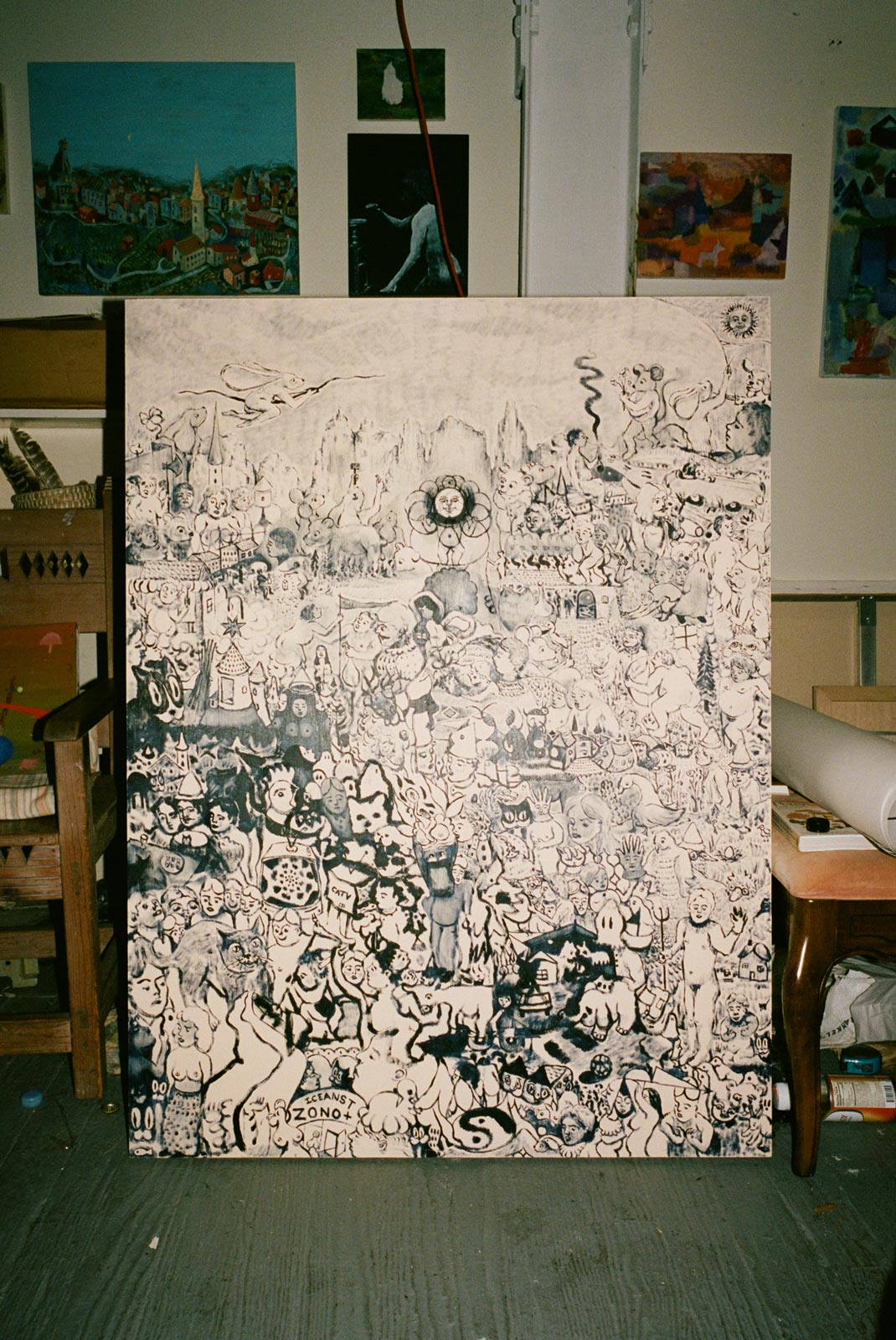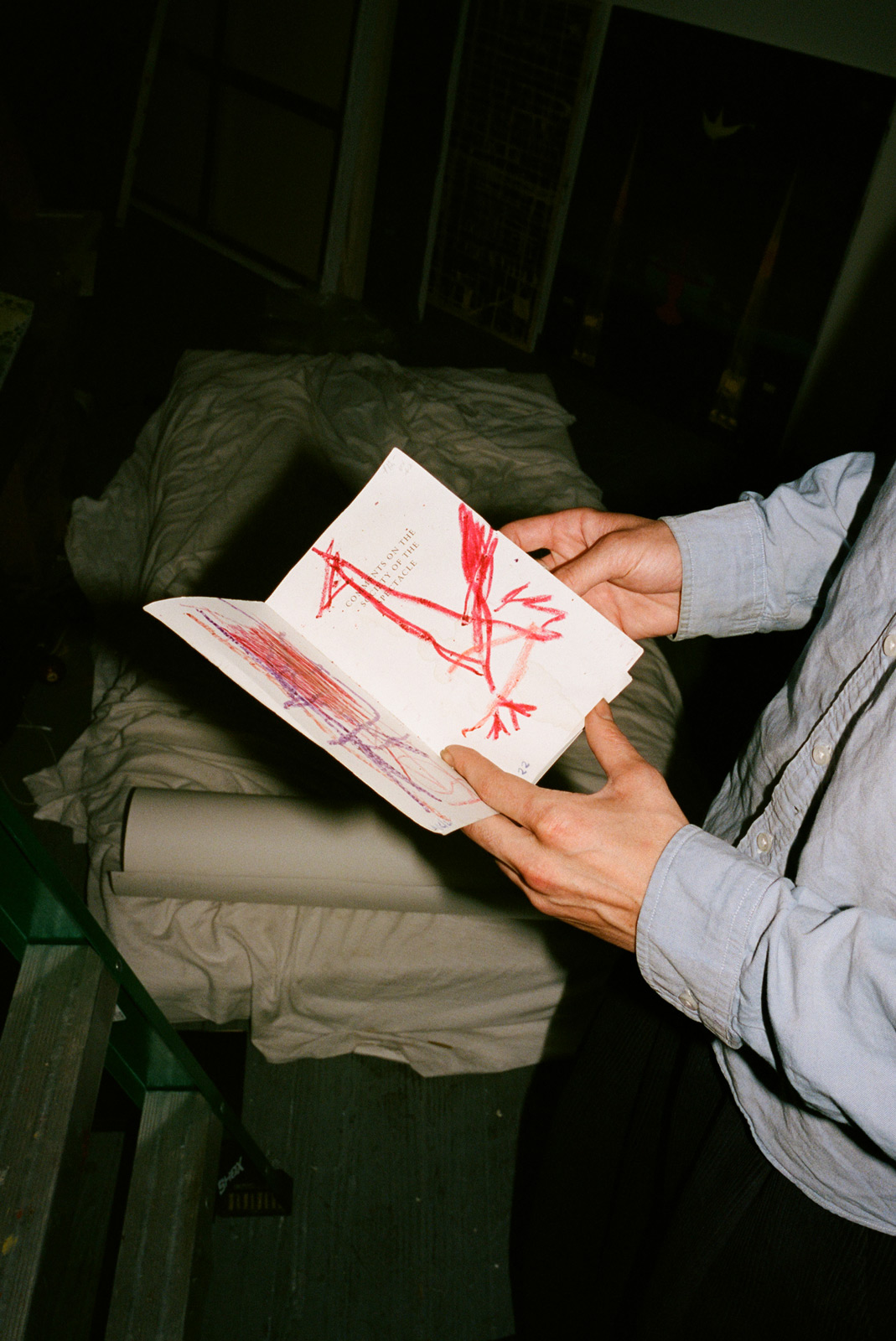To the Brooklyn-based painter, art is an opportunity to reinvigorate a sense of childlike wonder
The latest exhibition by Brooklyn-based artist Noel de Lesseps, The End, presented an inventive approach to imagined landscapes while referencing his hometown, Long Island’s East End. Held at The Ranch, the exhibition utilized texture, scale, and implied spirituality to transport viewers to an alternative world of whimsical imagery. His painting The fork and the sea, the centerpiece of the gallery, demonstrated de Lesseps’s intuitive approach to painting-as-play.
Looking to his childhood for inspiration, de Lesseps aims to cultivate a sense of curiosity in his work, similar to the freedom of exploration he felt in his youth. As such, all aspects of the artist’s lifestyle continue to contribute to the outcome of his art practice: From meditation and connection with the natural world, to skating, community, and dedication to imagination. “I don’t see how art can be something segregated from anything else,” de Lesseps says. “It is a free world, a magic one, that is real. It is a way of being, a state of mind, a philosophy.”
The artist joins Document to discuss his process of experimentation, maintaining an open mind, and what’s stimulating him as of late.
Syd Walker: Can you tell me a little bit about the preparation for your solo show in Montauk?
Noel de Lesseps: My show The End opened last month at The Ranch, a gallery run by Max Levai. Earlier this year, I was walking in the Met with my good friend, Megan Kincaid, who is director at The Ranch. She brought up the idea of putting on a show together. At the time, I was working on a large painting, The fork and the sea, which became the centerpiece. From there, Max, Megan, and I went into selecting other paintings to include. Both of them came into the studio to flesh out the show and discuss details.
Syd: Do feelings of anticipation, or even nervousness, hit the same as they did for your first solo show?
Noel: Going into it, there was some anticipation. At the opening, I felt a lot of love and enjoyed letting loose. It’s great to be with people in the moment, looking at art while connecting and sharing a space.
Syd: Your work has this ethereal, almost fantasy-like feeling to it. Where does that derive from?
Noel: When I was very young, [I had] an innate urge to discover and experiment. I would go outside and observe nature and play, soaking in the fulfilling energy of the natural world. It’s also from further back than I can remember, and beyond what I know—from the vital self, from spirit. My experience of the world was always abstract. When I was a little boy, my head was certainly up in the stars, in a state of wonder with existence itself and the most basic sensations.
All of my work is made through an imaginary process—improvising, going in and changing directions until I end up somewhere I could not have anticipated. To me, that is the nature of life that I resonate with. Many people can plan and execute, and that may have merit—and so may holding onto the past with envy or whatever, if that’s your philosophy. I see reality moving. What is expected to come might not, and things you did not expect will come. It’s an opportunity to let go, to be caught in a leap of faith by the net of the interconnected universe—to open up and wonder. If I don’t want anything in particular, I can end up somewhere unique, somewhere beautiful.
Syd: Do you find there to be an everlasting theme in your paintings? To reference past work, is there commonality between Penultimate and Trip to the Sun?
Noel: The work is in tandem with my psyche. Playing with natural phenomenology, with paint, is a momentary union of mind and matter. It’s an experiment, a vehicle for me to explore space, to accidentally create instances of environment by stumbling across a plane with whatever intuition happens upon my imagination in that particular moment—of which there will never be another. The works all resonate with a like essence, although manifested in alternate forms. I think the world is the material manifestation of spirit, so everything comes from the invisible world of spirit, from space… There is a bigger picture, the everlasting theme of consciousness.
Syd: Do you feel you are always in the studio producing and drawing up new concepts, or does it come in unprompted waves of inspiration?
Noel: After I began painting, I started doing it pretty much every day. I’ve been on the train for about five years, with some small breaks here and there. I end up preparing myself for work. My mind empties and I’ll be in my studio, breathing, looking around, spotting a material in the corner of my eye, and on a whim, making a penetrating jump into the work and setting things in motion. Of course, on the other end of motion there is rest and meditative generation.
Syd: Do you ever encounter burnout? How do you keep the fire alive when manufacturing a massive body of work?
Noel: Not usually. If I’m not painting, I’m doing something else. If I’m walking through nature, meditating, resting or sleeping. All of it is a part of work.
Syd: What’s exciting you as of late?
Noel: Painting, cats, Arthur Schopenhauer, Werner Herzog, my friends, numbers, water.
Syd: Your work is very dynamic. There’s almost a cathartic crowdedness that carries you through each image, emphasized when figures are involved. Can you speak a bit on that?
Noel: When painting, I’m working with environments. Elements arrive and I make connections. Relationships occur and bring me through the process. I just work until something feels whole, based on my sensibility. I like figuring out a painting. It’s a reflection of the world, coming through me. The world is crowded chaos. We reside in the middle of polarity, where we hang, spin, or whatever.
Syd: You grew up in New York. Do you think the lifelong stimulation of living in a city has been a springboard for you as an artist?
Noel: I grew up in New York, yes, but about a third of it has been in the city. I was around nature a lot as a boy in Switzerland, and out east in Long Island where the little forests were my haven. I’ve been painting for five years now, in Brooklyn for the most part, and really enjoy working here. The city is so dense and filled with life and new forms of nature. It’s extreme. Growing up, I had to escape from normal life to do art. I had to hide in my room pretending I was doing homework, and run away outside to do it, integrating it with my life. It has become my life now in a whole way, and I’m grateful for that.
Syd: Do you sense an evolution of mediums ever crossing your path, or do you imagine you’ll be painting for the foreseeable future?
Noel: Painting is my center in a way—it is sacred to me. I do work with a lot of other mediums, as well, but I don’t see how art can be something segregated from anything else, as it is indeed about the world. It is a free world, a magic one, that is real. It is a way of being, a state of mind, a philosophy.
Anyways, some other practices I keep are writing, hat-making, brush-making, drawing, performance art, video, and cooking! I make a mean stew. I’m working on my first feature film, which I’m thinking will wrap up next year. I’m really excited to show people, it’s been a big project for me.
Syd: Is there anyone you can refer to as a motivator in what you’re making today, artist or beyond?
Noel: God.
Syd: What’s next for you?
Noel: The horizon. Also I want to paint some fish paintings. I grew up with a blue painting in my bedroom, one of a fish—my half-sister Nadja made it. I don’t know where it is, but I remember it, and it’s been a [recent] source of inspiration for me.

















